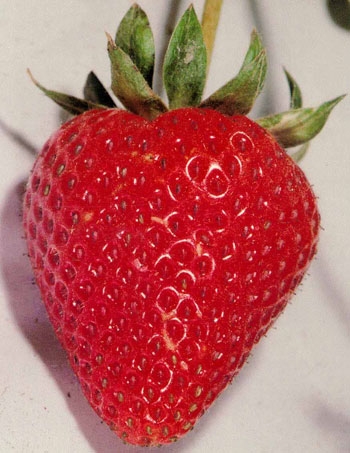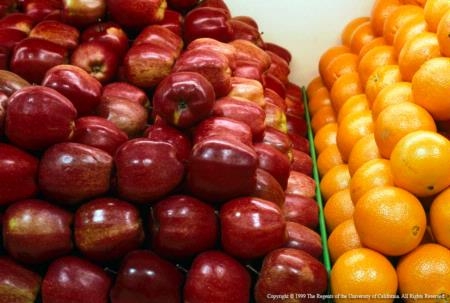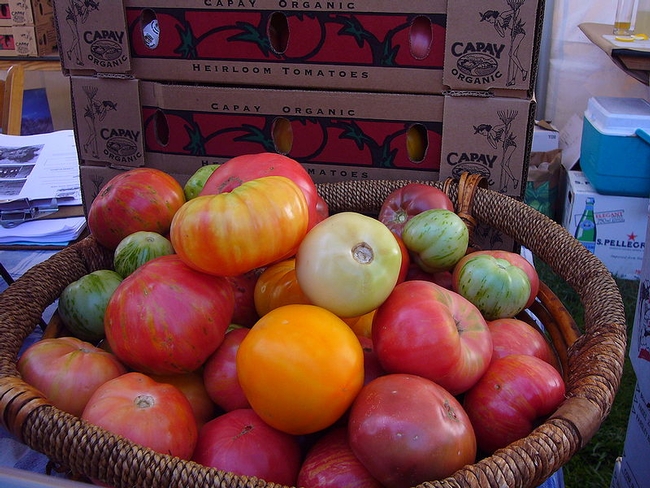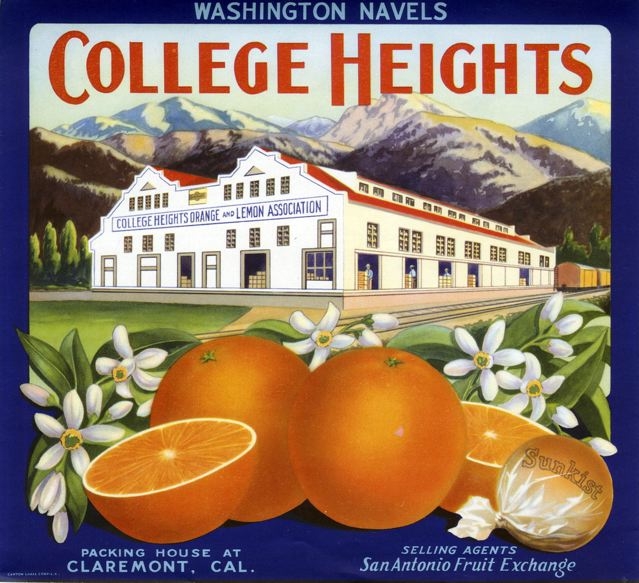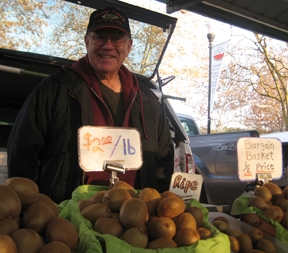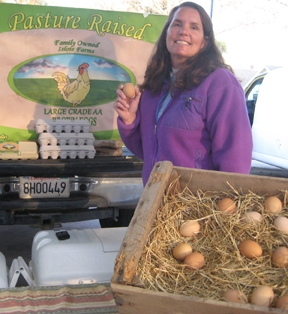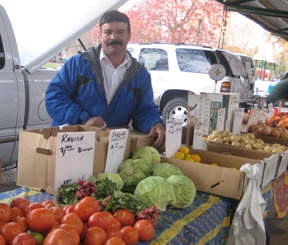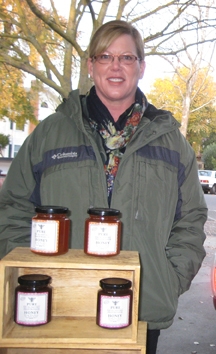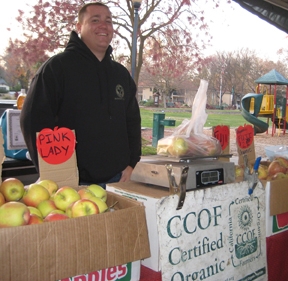UC Food Blog
Mind your food
One morning more than a decade ago I tried an “eating meditation” in Silverlake, about an hour’s drive from UC Riverside. We were about ten people – more Buddhish than Buddhist – in a dark and quiet room, seated on stiff chairs around a menacing-looking table. Each of us was handed a strawberry and told to await instructions.
I had never participated in an eating meditation before. I wasn’t even sure what was involved. Did one eat and eat, and meditate at the same time with eyes closed? I had tried two other kinds of meditation before – sitting and walking meditations. A meditation focused on food intrigued me, and it was simple curiosity that motivated me to try it out.
The instructions, when they came, were simple: We could feel the strawberry, smell it, examine it closely, and, yes, eat it in micro-bites. What we had to ensure, however, was that this exercise was continuous, that we sat in place, and that we were still doing at least one of these activities at the end of a half hour. We could not gobble down the strawberry or ask for more. What would work best, if we were set on just the eating activity, was to nibble at it – preferably molecule by molecule. Needless to add, the focus of the silent meditation had to be the strawberry as far as possible, and nothing else.
The exercise was not easy. For the first few minutes some of us collapsed into giggles. Later, the exercise turned uncomfortable and awkward. But as the minutes dragged by at what seemed a glacial pace, the atmosphere in the room transformed, embracing a seriousness the meditation deserved. I remember letting piece after tiny piece of strawberry linger on my tongue until I had “exhausted” the taste of each. I also remember closely scrutinizing the texture of the fruit, letting my fingers caress the rough skin, feeling the pattern of what, to my surprise, turned out to be hexagons wrapping the fruit, and marveling over the berry’s geometry and symmetry.
Until that morning, I had not examined a strawberry with such concentration, such patience. I had paid little attention to the small seeds piercing the surface, and had only barely noticed how the red hue deepened from the flat top of the fruit to the conical peak. There were times when the strawberry felt heavy in my hand; at other times I had to gently squeeze the flesh to resurrect sensations and bring my mind back to the meditation.
After a while, so lost were we in the exercise that time seemed to cease and nothing in the world mattered more than the strawberry in hand. Indeed, the universe shrank – or had it expanded? – to just me, the strawberry and the meditation. Where I ended and the strawberry began was hard to say, and irrelevant.
After we emerged from the meditation, the recommendation we were offered was to do the exercise daily, starting with half an hour (we could increase the time with practice, if we wanted) and a food of one’s choice – anything small, such as a grape or a small candy. What was not said but unanimously understood was that this exercise could be an effective way to overcome excessive and mindless eating, the lesson being you didn’t need too much of a food you crave to enjoy it well.
To friends who tell me they wish to lose weight, I recommend the eating meditation. Even if it fails to reduce your weight, I inform them, the great benefit of the exercise is that you become mindful of what you eat, how much and for how long. To date, none of these friends told me they took on the challenge. Can I be surprised? Given how frequently food ads on TV, the print media, and elsewhere assail us, I cannot censure them. Sadly, here’s my confession: It has been many years now since I did this meditation.
For more information on mindful eating, read the February 2012 New York Time article Mindful Eating as Food for Thought.
Beyond New Year's resolutions: tips for good health
Oh January 1st, how I hate you. If you’re like me you’re still recovering from the month long holiday food hangover. With three months until spring and swimsuit season on the horizon, you’re feeling the pressure to lose the winter coat! As always, you make that infamous New Year’s resolution: TO LOSE WEIGHT!
“Gym membership here I come!”
“I will not touch another carb for the rest of the year!”
“No sweets ever again… after this one!”
“I’m on a new diet, I eat nothing and when I feel like I’m going to faint I eat a cube of cheese!”
Okay the last one is my favorite quote from the Devil Wear’s Prada, but working in the health field I have found that sometimes people actually think that’s a solution. We find ourselves making resolutions that eliminate entire food groups from our diets, because we think it will help us lose weight. The thing most people don’t know or realize is that sometimes the absolutes we make can be very harmful to our health, and in the long run can actually cause us to gain the weight back plus more.
So this year, let’s make an attainable, realistic goal. Here are three tips selected from www.choosemyplate.gov, to have a healthy year!
- Put a positive spin on it – instead of saying “I can’t eat any sweets at all!” try a few “I will” statements on for size:
- I will add 1 serving of fruits and vegetables to each meal.
- I will make half of my grains whole.
- I will choose water or low-fat milk more often.
- Build a healthy snack – instead of buying the expensive processed snacks, try these healthy tips:
Combine fruit and a dairy food for the morning munchies:
- Apple and cheese
- Banana and yogurt
Combine vegetables and a protein food for a p.m. pick-me-up:
- Celery and peanut butter
- Carrots and almonds
Combining these foods will help you stay fuller longer while increasing your nutrient consumption.
- Don’t discount physical activity – being healthy isn’t about just what you eat. Adults need 30 minutes of physical activity a day and children need 60 minutes. Just because you don’t have a gym membership doesn’t mean you can’t be physically active. Remember that 30 minutes can be broken up throughout the day.
Here are some tips to increase your physical activity incrementally, without breaking the bank:
- Start a walking club with your co-workers, neighbors or friends. You’re more likely to do it if someone keeps you accountable.
- Do what you like! If you hate to run, don’t do it. There’s no use in driving yourself crazy doing something you hate. If you like to dance, then turn the radio up and have fun!
- Do stretches, exercises, or pedal a stationary bike while watching television.
Remember to always consult your physician before beginning a rigorous exercise regimen.
May your new year be full of realistic, attainable, resolutions! Keep it positive. Select healthy snacks that help you stay full longer. Get moving so you have more energy during the day. For more information and health tips visit www.choosemyplate.gov.
Wishing you all a very healthy 2012!
Heirlooms, civic agriculture and a New Year's resolution
“Heirloom” is an interesting term, and like the word “sustainability,” it means different things to different people. Recently, I read The Heirloom Life Gardener, a book written by Jere and Emilee Gettle. The Gettles are the co-founders of the Baker Creek Heirloom Seed Company, which publishes a lush and incredibly informative seed catalog and has spun off a variety of gardening-related enterprises across the nation. The Gettles define heirloom seeds as being “nonhybrid and open-pollinated” and as usually having been in circulation for more than 50 years. Some heirloom seed types currently in use could have been found in Thomas Jefferson garden at Monticello. Some appear more recently, during the Great Depression, including the Mortgage Lifter tomato (who couldn’t use one of these in today’s economy?).
While reading the Gettles’ book, I began thinking once again about the relationship between land and the American character. I was inspired to pull some of my favorite books off the shelf and revisit them, to consider the notion of “civic agriculture.”
The term “civic agriculture” - coined by the former Thomas Lyson of Cornell - is used by some to refer to the movement towards locally based agricultural models that tightly link community, social and economic development. Models of civic agriculture include CSAs, farmer’s markets, roadside stands, urban agriculture, community gardens, and farm-to-school/farm-to-institution programs. I also argue that civic agriculture includes school and home gardens . . . any place where people seek to connect land to the development of community or as an expression of engagement or citizenship.
The civic aspect of agriculture is much older than the current local food movement; it hearkens back to our nation’s founding. The connection between land and democracy has always held real meaning in American culture. Jeffersonian ideals about the civic virtues and value of gardening and agriculture were prevalent and shaped American cultural and political life; the U.S. Department of Agriculture, created in 1862, was called “The People’s Department” by President Abraham Lincoln. Lincoln once told a group of Wisconsin farmers that as long as Americans knew how to cultivate even the smallest plot of land, that the nation’s citizens would be free from kings and moneylenders, free from oppression of all sorts.
Federal legislation such as the Morrill Act (we will celebrate its sesquicentennial in 2012, and I'll be writing about that throughout the New Year) created America’s land-grant institutions, which still have as a primary purpose research and education in support of the nation’s agricultural producers. (Land-grant institutions through their Master Gardener programs also support home and community gardeners). The Homestead Act, also passed in 1862, and linked the cultivation of land to the protection of the Union and the expansion of democracy during the nation’s Civil War. You’ve heard this from me more than once: We were a nation of farmers at origin; we are still a nation of farmers at heart.
We farm, and we garden. Gardening links the myth and the practice of agriculture to one another. In practice, gardening is agriculture on a personal scale; it represents an individual's relationship to a specific piece of land. This is a kind of relationship worth investing in.
As the longest, darkest days of the year are upon us, as you celebrate the best things that family and hearth offer, and as you formulate your goals and hopes for the New Year, I hope that you’ll consider adding another resolution to your list: to embark upon a gardening activity, no matter how small, in 2012. Occupy the possibilities that gardens create at our homes, and in our communities.
Happy Holidays, and a Healthy and Prosperous New Year.
“A Garden for Everyone. Everyone in a Garden.”
Los Angeles and the “Orange Empire”
An interesting book called “Orange Empire: California and the Fruits of Eden” by Douglas Cazaux Sackman tells the story of how oranges went from being an occasional treat to a mainstream part of the American diet. In fact, Los Angeles was once the center of the “Orange Empire” which developed into a massive industry in California.
Oranges were brought by the Spanish as they settled the missions, and the first sizable grove in Alta California was planted at the San Gabriel Mission, near Los Angeles, around 1804. Oranges were grown on a very limited scale until a frontiersman and entrepreneur named William Wolfskill decided to try growing oranges commercially, using seedlings from the Mission. His initial two-acre orchard was planted in 1841 in what is now downtown Los Angeles. During the Gold Rush, he was able to ship his citrus crop north to miners who were willing to pay a premium to protect themselves from scurvy.
The citrus industry in Southern California grew slowly at first, then really took off in the 1870s due to two innovations. First, a family in Riverside obtained two trees of an orange variety from Brazil. The fruit from these trees was larger, sweeter and easier to peel. This variety, which came to be known as the Washington Navel, created a surge of interest in growing oranges. In the same decade, the transcontinental railroad system connected to Los Angeles, and the very first railcar load of oranges, from the Wolfskill orchard, was shipped east in 1877. In the late 1880s, with the advent of refrigerated rail shipping, the growing citrus industry got another boost. Many new growers entered the citrus farming business, and numerous towns along the foothills of the Los Angeles basin were formed as the industry grew up in those areas.
“Centered on the Los Angeles basin, a vast citrus landscape was coming into being,” said Sackman (p.42). “In 1870, only 30,000 orange trees were growing in the state. Twenty years later, 1.1 million trees were producing fruit." By 1893, local citrus growers had organized themselves into the Southern California Fruit Growers Exchange, which later became known as Sunkist. Sunkist was instrumental in driving the demand for oranges, promoting oranges and orange juice as health aids, with national advertising campaigns beginning in 1907. Sunkist advertisements, along with colorful orange crate labels, helped to brand Los Angeles and Southern California as a new Eden, the land of sunshine and good health. This image helped to drive migration from to Southern California for many years.
Commercial citrus production in Los Angeles County began to decline after World War II, as orchards were rapidly sacrificed to the growing, sprawling suburbs of the Los Angeles basin. As recently as 1970, there were still more than 50,000 acres of citrus in the county; but today, most orange trees in Los Angeles are in backyards rather than in groves.
The citrus industry, still critical to California’s agricultural economy, has long since moved to other counties and other parts of the state. While there is no longer an “Orange Empire” here in Los Angeles, oranges are still a treat, especially if grown in our own backyards. As I prepare for the holidays, I know that today, an orange in a stocking might not be as special as it once was. But to pluck an orange off a tree, on a 75 degree day in December, still makes Los Angeles seem like Eden to a former Midwesterner like me.
December farm stories
Davis Wednesday afternoon farmers' market can be quiet in December, so what better time to learn a little about what's going on back at the farms? Every farmer I talked with today had delicious treats to sell and a story to tell. Here are a few:
Did you know that Gridley is the kiwi capital of America? There used to be a kiwi festival and a kiwi queen, but that all got too expensive for Gridley's kiwi farmers quite a few years ago, Frank Stenzel reports. He's getting ready to start pruning his 14 acres of kiwi vines next week; pruning will take a crew of 12 about two weeks. After pruning, each of the 25 or 30 canes on each kiwi vine will need to be tied to a trellis, very much like grape vines, to be ready for next year's growth.
The fuzzy green fruit for sale today from Stenzel's Kiwi Farm was harvested late in October and has been held in cold storage at 32 degrees since then. The fruit will last about six months stored this way, allowing Stenzel to bring out what he needs, grade it by size, let it ripen a little, but sell it while it's still firm. When you bring your kiwis home, let them ripen three or four days more for the best flavor.
Now that the weather is getting colder, the older chickens at Annette Jones' Islote Farms in Esparto have started molting. For a few weeks, they will lose feathers and stop laying eggs. But Jones isn't worried; in fact, she planned for this. Younger hens are picking up the slack because they hatched later in springtime and are just starting to lay eggs in December and January. The older hens can take their much needed break while the youngsters get busy. The fresh eggs from the younger hens are available at the market today in small and medium sizes. When springtime comes, all the birds will be laying again and eggs will be plentiful.
On Federico Toledo's Toledo Farm in Lodi, his son, brother, brother-in-law and other family members are busy planting this month - cabbages, broccoli, cauliflower, spinach, beets, cilantro, carrots, onions and curly parsley. What they're planting now will be at the farmers markets in March, April and May, if the weather cooperates. The 20 long rows of onions going in now will yield green onions in February and March, full-size fresh onions in April and May, and then dry onions in June and July. Today's market table has stories too: The last red tomatoes of the year are for sale today; they were picked green in November and ripened with a heater. The winter squash was actually grown in summer and harvested in August - it gets sweeter over the months and keeps well in winter. The persimmons, grapefruit, lemons and apples were all fresh-picked by the farm family.
All the rice has been harvested now at Robin Harlan's Bullfrog Farms in Winters, and the 3,000 hives of Bullfrog Bees are getting pollen patties to make it through the winter since there aren't enough blossoms to keep them fed without help this time of year. There's time now for bottling the honey; it's been stored in big stainless steel barrels since the Harlans harvested it in the summer. Bullfrog Farms grows more than 200 acres of almond trees which start blooming in January, so the bees will have blossoms very soon to pollinate and pollen to gather for more honey. After working in the Bullfrog orchards, they'll go to Blue Diamond almond orchards, and then to orange groves in Winters. Local honey is the sweet result of these hard-working bees.
Todd Evans works at certified organic Mount Moriah Farms in Clements. Today he's selling crisp Fuji and Pink Lady apples. Up until two days ago, Evans, farm owner Steve Smit, and a couple of other guys were harvesting apples. Now they're getting ready to prune all the trees, which will take the four of them about a month. The apples should last in storage until about May, just long enough for the cherries to be ready.
Give it a try - visit your local winter farmers market and learn some new stories!
To find farmers' markets in your community, visit the UC small farm program's California Agriculture Tourism Directory.


